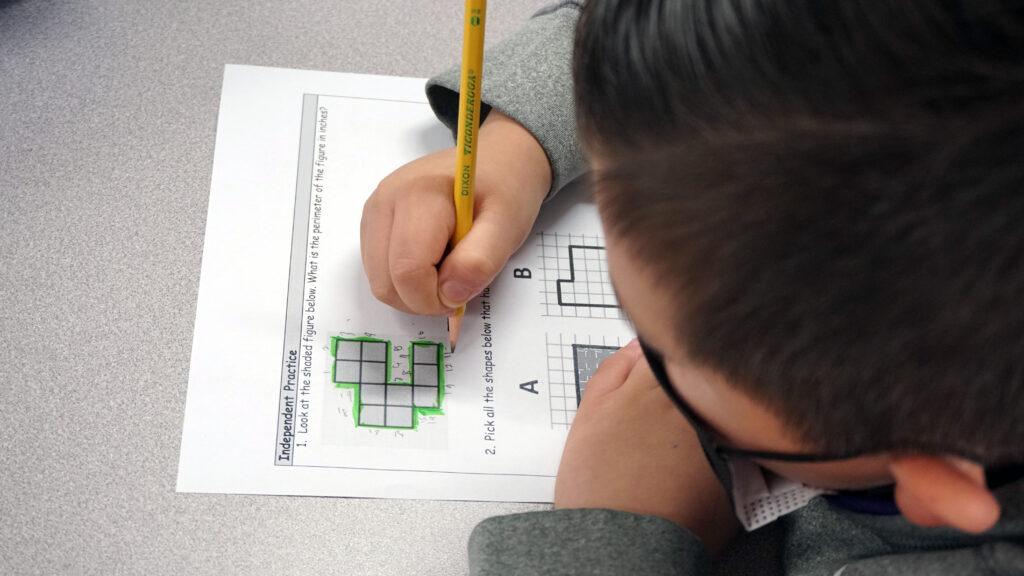
Credit: Andrew Reed / EdSource
As a former math teacher, every Teacher Appreciation Week reminds me of the math-themed gifts I received from students — from a personalized calculator to a coffee mug adorned with equations.
As I reflect on my time teaching, I realize that alongside these gifts, what would have empowered me most as a math teacher was consistent access to a high-quality curriculum: one that is content-rich, enables each and every student to deeply understand and apply math in meaningful ways, and supports — not replaces — teachers’ professional judgment.
Research shows that high-quality instructional materials, together with teacher professional learning aligned to them, are a potent combination to help teachers improve math outcomes for students. Plus, high-quality materials save teachers precious time, as teachers spend an average of seven hours per week searching for or creating their own materials.
Ensuring access to high-quality instructional materials aligns with the California Mathematics Council (CMC) mission to support and empower a thriving mathematics community dedicated to fostering effective teaching and learning for every student in California. We believe that mathematical thinking, reasoning, and problem-solving are critical to students’ future success and to our state economy.
We also know that California students and educators have incredible strengths and potential. I have seen firsthand how students and educators thrive when given opportunities to engage with authentic, relevant math content. Unfortunately, though, the most recent Nation’s Report Card shows that California students’ math achievement lags behind national averages and remains below pre-pandemic levels.
Moreover, California trails the nation in how our education leaders understand, identify and use high-quality instructional materials to boost math learning. A recent poll from Gallup found that only 11% of California’s district leaders and school principals are very familiar with high-quality instructional materials, compared to 20% of their peers nationally. Similarly, only 13% of California leaders said their district had an official definition of high-quality instructional materials — significantly lower than the 25% of leaders nationally who said the same. And only 11% of the leaders in our state say all the math professional learning in their school or district is aligned with their math curriculum, compared to 22% nationally.
For high-quality instructional materials to empower teachers to unleash their care, creativity, and knowledge in supporting students’ math learning, California must have a stronger and clearer vision of what constitutes quality in curriculum. This should start at the state level, as Gallup found that more than three in four California district leaders and principals say they look to state guidelines when deciding whether a curriculum is high-quality.
Fortunately, state leaders have an imminent and critical opportunity to lead with a clear definition of quality. This summer, the state will engage teacher-reviewers to evaluate and select instructional materials to include on the state list of recommended math curricula. In advance of the review process, the state’s Instructional Quality Commission should define ‘high quality’ in math curricula and ensure that all of the recommended materials meet this definition. The recommended materials should also align with state standards and include the instructional strategies reflected in the 2023 California Math Framework to promote every student’s access to grade-level content.
Also at the state level, leaders should provide professional learning to support the implementation of these materials and allow teachers to lead this work with integrity and impact. Gov. Gavin Newsom allocated $250 million for math coaches in the budget he proposed in January. It is critical that the Legislature acts on the governor’s proposal and continues to invest in math teachers’ development, including through professional learning and coaching aligned with high-quality materials.
District leaders must also clearly define what high-quality materials mean in their context and use this definition to guide their district’s math materials selection process. This definition from a coalition of organizations committed to high-quality math materials offers more guidance for district leaders as they define their vision.
For both our students and our state to thrive, we must ensure our teachers have high-quality materials to foster achievement and joyful experiences in math. Let’s appreciate California’s teachers — during this Teacher Appreciation Week and every week — by equipping them with the high-quality resources they deserve as they do the indispensable work of nurturing the mathematical understanding of each and every student.
•••
Ma Bernadette Andres-Salgarino is the president of the California Mathematics Council. She is also the assistant director of iSTEAM at the Santa Clara County Office of Education.
The opinions expressed in this commentary represent those of the author. EdSource welcomes commentaries representing diverse points of view. If you would like to submit a commentary, please review our guidelines and contact us.

دیدگاهتان را بنویسید